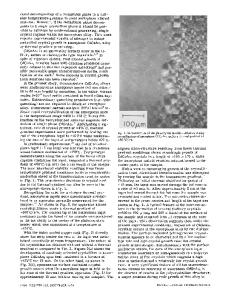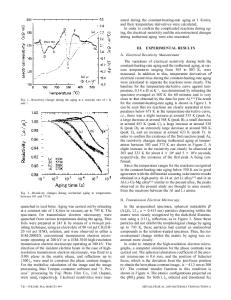Thermal oxidation behavior of an Al-Li-Cu-Mg-Zr alloy
- PDF / 906,626 Bytes
- 9 Pages / 594 x 774 pts Page_size
- 98 Downloads / 328 Views
I.
INTRODUCTION
ALUMINUM alloys containing 2 to 3 wt pct lithium offer an attractive combination of mechanical properties, particularly in terms of reduced density and increased stiffness. Since lithium is highly reactive, one may expect that during thermomechanical processing of A1-Li alloys, lithium may diffuse to the surface and react with the atmosphere. Lithium metal reacts with the non-metals except the inert gases, most of the metalloids, and many of the metals under proper conditions. It is known that when A1-Mg alloys are heat treated during their production and fabrication, magnesium is depleted from the bulk of the material with the formation of magnesium rich oxide. 1Hine et al. 2 studied the oxidation of aluminum-magnesium alloys in the temperature range 440 to 540 °C and showed that the oxidation rate depends on the concentration of magnesium in the alloy and a magnesium depleted layer is formed next to the oxide film. Textor and Grauer 3 studied the oxide composition of technical pure aluminum by X-ray photoelectron spectroscopy (XPS) and secondary ion mass spectroscopy (SIMS). They found that after thermal annealing Li, Mg, and Na were strongly enriched at the surface. In situ electron microscopic study of oxidation of an AI-1 wt pct Li alloy at 475 °C and at low partial pressure of oxygen was performed by Scamans and Butler. 4 They report formation of spinel LiAlsO8 oxide crystals. Fridlyander and his co-workers s studied the thermal oxidation of an 01420 (A1-5 wt pct Mg-2 wt pct Li) alloy in air, and Li2Co3 and MgO were reported to be the predominant crystalline phases. Field et al. 6 studied oxidation of A1-3 wt pct Li and A1-3 wt pct Li-2 wt pct Mg alloys in the temperature range 480 to 575 °C. The results of transmission electron microscopic study under dry conditions showed the initial amorphous A1203 film is replaced by the following oxide phases: primary y-LiAIO2 (epitaxial), secondary MgO, and Li20. MAQSOOD AHMAD is Research Assistant, Division of Engineering Materials, Department of Mechanical Engineering, Link~ping Institute of Technology, S-581 83 Linkrping, Sweden. Manuscript submitted April 11, 1986. METALLURGICALTRANSACTIONS A
Csanady et al. 7 studied the influence of Cr, Cu, and Li additions on high temperature oxidation of AI-Zn-Mg alloys. The MgO, LisA104, and LiAIsOs oxide phases were detected by X-ray diffraction for the alloy heat-treated at 500 °C for 160 minutes in air. Previous studies of A1-Li-Cu-Mg-Zr alloys by means of microhardness measurements have shown that during heat treatment of the alloys a soft surface layer is formed. 8'9 Recently there have been several investigations dealing with the problem of oxidation of the A1-Li alloys. ~°'n'n The aim of our work was to study the compositional and structural changes occurring during the heat treatment at the surface of the A1-Li-Cu-Mg-Zr alloys. The surface composition and concentration profiles through the oxide layer were determined by AES (Auger Electron Spectroscopy) in conjunction with argon ion sputtering. The oxide
Data Loading...











